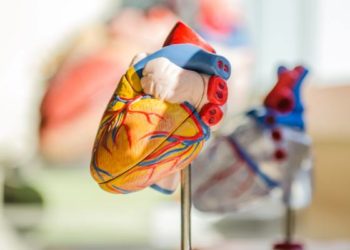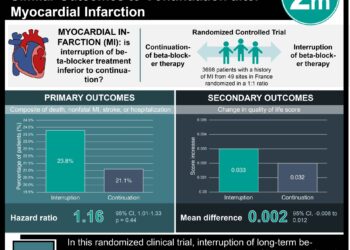Unrecognized myocardial infarctions associated with embolic cerebral infarctions of undetermined source
1. In this cross-sectional cohort study of older adults in Iceland, MRI findings of myocardial infarction was associated with coincident MRI findings of cerebral infarction.
2. Patients with embolic patterns of cerebral infarction, without a clear source, had a higher likelihood of unrecognized myocardial infarction diagnosed by MRI.
Evidence Rating Level: 2 (Good)
Study Rundown: Despite full investigations, the etiology of a significant number of cerebral infarctions remain undiagnosed. In this cross-sectional sub-cohort study involving 925 patients from the ICELAND MI registry, both recognized and unrecognized myocardial infarction (MI) was associated with increased risk of cerebral infarction on MRI. Unrecognized MI was also associated with embolic cerebral infarctions of undetermined source.
This study suggests that unrecognized MI may be a risk factor for embolic cerebral infarction of unknown source, and also adds weight to the clinical relevance overall for unrecognized MI. Limitations include small sample size and limited demographics. Overall this highlights the potential value of more aggressive secondary stroke prevention in patients with unrecognized MI.
Click to the study in JAMA Neurology
Relevant Reading: Embolic Stroke of Undetermined Source A Systematic Review and Clinical Update
In-Depth [cross-sectional study]: This was a sub-cohort study using the ICELAND MI registry of 30,795 randomly selected Icelandic patients born between 1907 and 1935. All surviving patients at the time of enrollment (January 2004 – January 2007) were eligible if they could provide informed consent, safely undergo MRI, and receive intravenous gadolinium. Primary outcome was rates of cerebral infarction relative to presence of unrecognized vs recognized myocardial infarction. Myocardial infarction (MI) was defined as late gadolinium enhancement consistent with ischemic scar in terms of pattern and location. Myocardial infarction was deemed unrecognized if there was no hospital or clinical record. Demographic and vascular risk factors, including age, gender, hypertension, diabetes mellitus, hyperlipidemia, atrial fibrillation or flutter, heart failure, serum creatinine, alcohol use, and active tobacco use were all collected.
A total of 925 participants underwent diagnostic cardiac and brain MRI. Mean age was 75.9. Of the cohort, 221 participants (23.9%) had evidence of myocardial infarction, 68 recognized (30.8%) and 153 unrecognized (69.2%). There were 308 participants who had evidence of cerebral infarction (33.3%). After adjusting for demographics and vascular risk factors, patients with recognized MI and unrecognized MI both had increased risk of cerebral infarction (recognized OR 2.0, 95%CI [1.2-3.4], p=0.01) (unrecognized OR 1.5, 95%CI [1.02-2.2], p=0.04). Ninety-three participants (10.0%) had embolic cerebral infarcts of undetermined source. Unrecognized MI was associated with increased likelihood of embolic cerebral infarcts of undetermined source (OR 2.0, 95%CI [1.1-3.5], p=0.02).
Image: PD
©2019 2 Minute Medicine, Inc. All rights reserved. No works may be reproduced without expressed written consent from 2 Minute Medicine, Inc. Inquire about licensing here. No article should be construed as medical advice and is not intended as such by the authors or by 2 Minute Medicine, Inc.






